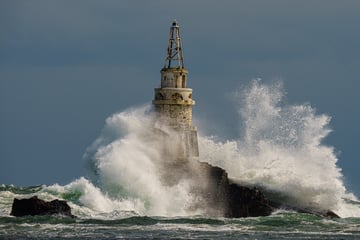Perhaps they are one of the most striking and impressive looking atmospheric phenomena out there. But don’t be fooled by the shiny white tops and friendly popcorn-like appearance, as they can produce a wide variety of malicious weather, capable of bringing your maritime operations to a complete standstill. We are obviously talking about convective clouds here. In this article you will find out how and why these clouds develop and how to recognize them, allowing you to take timely measures.
Imbalances
Within the earth’s atmosphere temperature gradients are generally the main driver behind the movement of air, both horizontally and vertically. As physics won’t allow for these gradients to become infinitely large, compensating forces come into play to restore the thermal imbalances. Even synoptically scaled weather phenomena, like the jetstream for example, originate from thermal gradients which, in their turn, imply strong pressure gradients. We perceive the resulting movement of air as the common weather phenomena we are all familiar with.
Convective clouds are the result of buoyancy forces emerging from vertical temperature gradients where relative warm air is positioned beneath rather cool air aloft. Warm air is more buoyant (less dense), so it has the tendency to ascend. During this process the pressure decreases, and the air expands whilst cooling down. Eventually water vapor condenses into water droplets, forming a convective cloud (see Fig.1).

Fig.1: warm air rises as a result of buoyancy forces, forming a convective cloud.
The release of condensation heat fuels the rising column of air (updraft). As long as the updraft remains warmer than the ambient air the vertical movement will continue and possibly even strengthen. In highly unstable settings updrafts can become vigorous with speeds occasionally exceeding 100 km/h. Obviously, this leads to severe thunderstorms with very large hail and damaging gusts.
The tropopause, the boundary between the troposphere and stratosphere, acts like an impenetrable cap for all updrafts due its thermodynamic gradient stratification. Meaning that from there on up the drop in temperature with height stops or becomes less steep. The tropopause varies in height: from around 20 km in tropical areas to roughly 7 km on the poles. Hence, convective clouds will reach much higher in warm subtropical regions.
The strongest updrafts occasionally manage to reach into the lower regions of the stratosphere for a short period of time, as the momentum of the rising air is far too great to be stopped instantly, before leveling out underneath the tropopause. This leads to so-called overshooting tops and gravity waves near the top of the troposphere which can be clearly seen on satellite imagery (see Fig.2).

Fig. 2: A thunderstorm with several strong updrafts overshooting the main anvil, shortly making their way into the lower stratosphere, as seen from the ISS. Source: NASA.
Appearance
Convective clouds appear in various forms. Depending on the depth and strength of associated updrafts they consist of water, supercooled water and/or ice particles. Liquid cloud water usually leads to a solid looking cloud with sharp edges and a greyish to off-white appearance, while the icy top is shiny white and eventually feathers out. Whenever a temperature inversion is reached the top of the cloud will flatten out underneath. One can generally state that the deeper the unstable profile, the higher updrafts will reach and the more likely showers and thunderstorms will become (see fig 3, 4, and 5). In the latter case profound anvils will give away the presence of severe weather coming up.
 |
 |
Fig. 3 Left: shallow Cumulus clouds underneath an inversion. Right: the tiny red line near 800hPa represents the trajectory of the small clouds in a sounding. Source photo: Ronald Watchman.
 |
 |
(Fig. 4: Left: Cumulus Congestus. Right: trajectory of the clouds. Notice these clouds reaching higher into the atmosphere. Source photo: Merikanto)
 |
 |
(Fig. 5: Cumulonimbus Capillatus with developing anvil. Right: in red the trajectory of the cloud. Source photo: Oscar den Uijl)
Convection at sea
Summer
Since convection is a result of atmospheric instability, the midlatitude summer season is prime time for the occurrence of thunderstorms over land. Obviously, this has to do with stronger diurnal heating compared to maritime areas. However, thunderstorms occasionally roll offshore, especially when organized in clusters/squall lines. In the latter case they pose a serious threat for any offshore operation as strong gusts are the main hazard. These clustered or lined up systems exhibit strong cold pools spreading out over large areas. Near the leading edge of these gust fronts characteristic Shelf clouds frequently rush forward.

Fig 6. Classic Shelf cloud. In this case the core of the thunderstorm was located onshore, but the cold air spreading out underneath also rolled offshore. Near the leading edge the formation of this Shelf cloud occurred. Also, notice the strong precipitation column on the left side of the picture, which reveals the position of the parenting thunderstorm on land just outside of this picture. Source: James Spann.
More common for offshore locations are so-called elevated settings which disengage the thunderstorm’s dependance on warm air near the surface. In these circumstances the warm and unstable air is present at the midlevels of the atmosphere, allowing for thunderstorms to easily develop from a certain height over sea as well. In this case, there must be some sort of lift mechanism in place affecting the warm and unstable air, such as an upper trough or frontal system. The risky part of an elevated setup is that the maritime boundary layer is moist and stable and often susceptive to the development of fog and/or low clouds, possibly obstructing visibility on the upcoming thunderstorms aloft. As a result of the stable setting near the surface strong gusts are less likely to occur with the passage of this kind of thunderstorm (see fig 7).
 |
 |
(Fig 7. Left: heavy elevated thunderstorm showing up on enhanced color infrared satellite images over the northern German Bight on August 13th 2024. Right: associated sounding with the red line indicating the trajectory of convective clouds. Cloud base around 3km, cloud top in this case well over 12km.)
Winter
During wintertime convection is most pronounced over sea and coastal areas as the water is relatively warm compared to the air aloft. Usually showers and thunderstorms are smaller, less deeply rooted in the atmosphere and the frequency of lightning is much lower compared to their summer counterparts. Classis outbreaks of wintry showers with occasional flashes occur when polar or arctic air spreads out over warmer waters. Given the low flash rate, these thunderstorms tend to catch offshore crews by surprise. With these shallow showers there’s also a risk of AIL, aircraft induced lightning, reducing the mobility of helicopters.
The (sub)tropics
In the tropics the ITCZ, Intertropical Convergence Zone, is the main trigger for convective activity. As trade winds converge along the ITCZ, they consistently aid areas of enhanced lift in the very warm and unstable air mass; hence allowing deep convective activity to take place. Usually this happens under circumstances whit no to little vertical windshear. As a result, individual showers and thunderstorms usually have a short lifespan. Merged coldpools can occasionally regroup the convective elements along their leading edge though, giving rise to long-lived fast moving squall lines. Associated gusts are the main hazard in that case.
Atmospheric disturbances moving westwards along the ITCZ (such as ‘easterly waves’ over the central Atlantic basin) are areas where additional low level convergence causes excessive thunderstorm activity. Once over open ocean they can be the spawning ground for tropical depressions and hurricanes as the widespread convection starts to interact with the Coriolis force just north and south of the Equator. When convection interacts with the AEJ (African Easterly Jet) during the northern hemisphere summer, vertical windshear increases. The risk of tropical storms and Hurricanes then decreases, but large westward moving clusters (MSC/MCC) with strong squall lines can develop instead.

(Fig 8.: Hurricane Beryl enters the Caribbean Basin on July 1st 2024. The system originated as an easterly wave along the ITCZ just W of Africa and experienced rapid upscale growth on its way across the Atlantic).




